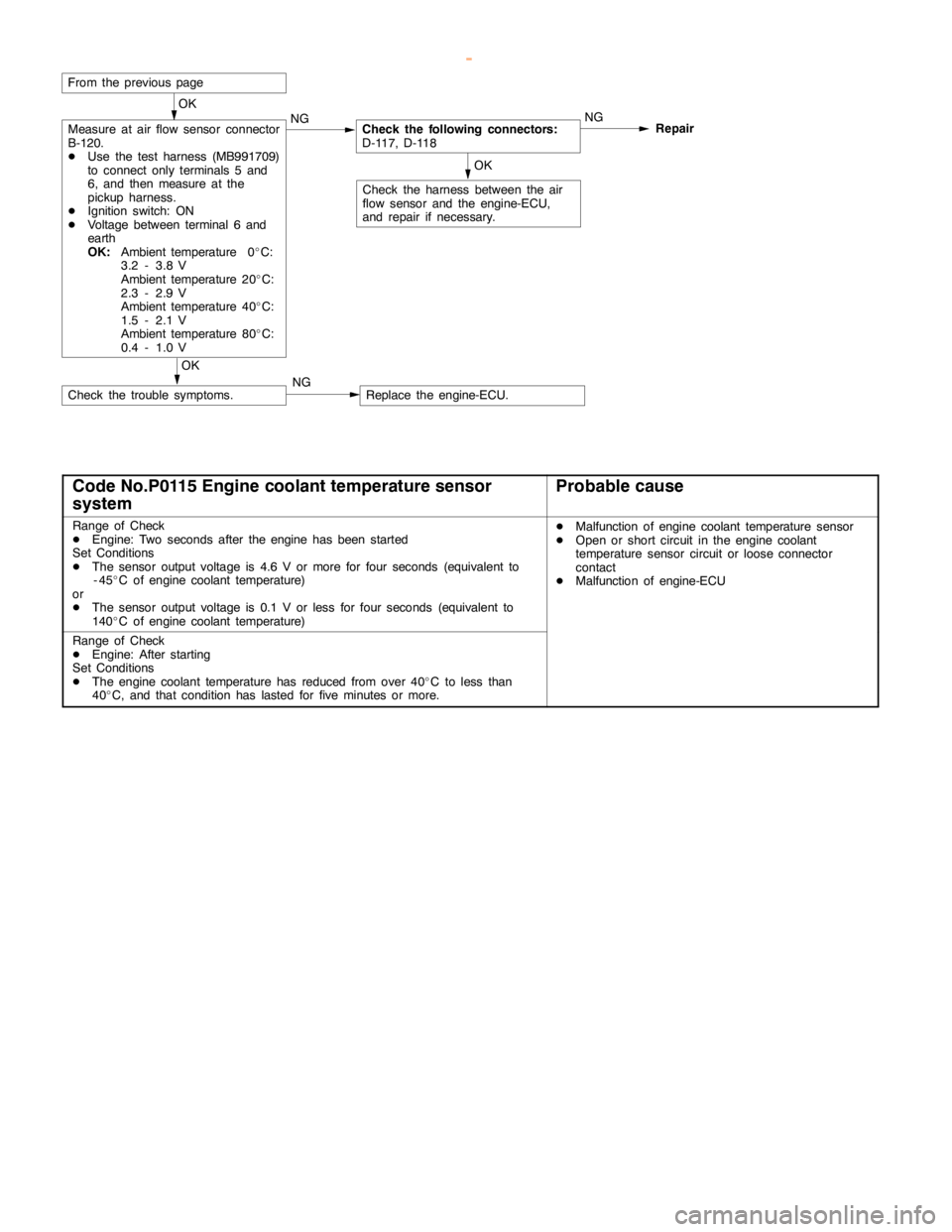coolant temperature MITSUBISHI MONTERO 2000 Service Repair Manual
[x] Cancel search | Manufacturer: MITSUBISHI, Model Year: 2000, Model line: MONTERO, Model: MITSUBISHI MONTERO 2000Pages: 1839, PDF Size: 29.19 MB
Page 46 of 1839

3 MSB-00E00-505
3. Details:
Contents of Attachment are to be added to GROUP 00 (GENERAL).
PRECAUTIONS BEFORE SERVICE
LEARNING FUNCTION OF GDI ENGINE
1. Purpose
On the GDI engine equipped cars, when replacement of the ECU (for engine control) or resetting
of the battery* has been performed, an idle learning function of the ECU (for engine control) will
be required.
The idle learning function will be completed by running the engine at idle by the following procedure.
NOTE:
*: Disconnection of ECU (for engine control) battery backup power supply (disconnection of battery
terminals or ECU connectors)
2. Idle Learning Procedure
(1) Start the engine, and warm up the engine until its coolant temperature reaches 85°C or higher.
When the engine coolant temperature is 85°C or higher, you have only to turn the ignition
switch to the ON position.
(2) Turn the ignition switch to the LOCK (OFF) position, and stop the engine.
(3) After lapse of ten or more seconds, restart the engine.
(4) Run the engine at idle for ten minutes under the following conditions.
DTransmission: Neutral (P range for automatic transmission)
DAir conditioner and heater: Not operational
DEngine coolant temperature: 83°C or higher
(5) Stop the engine.
(6) Restart the engine, and run it at idle for ten minutes under the following condition.
DTransmission: Neutral (P range for automatic transmission)
DAir conditioner: Operational (Temperature set at “maximum cool”, fan at high speed, and
windows fully opened)
DEngine coolant temperature: 83°C or higher
(7) Repeat steps (5) and (6).
NOTE:
1) When the atmospheric temperature is 20°C or more and the air conditioner has continuously
been operated, step (7) may be omitted.
2) During idling operation of the engine in steps (4) and (6), when engine operation switches
from lean operation to stoichiometric operation, engine stall can occur. In this case, clean the
throttle body (throttle valve) thoroughly, and then repeat step (1) and the subsequent steps.
www.WorkshopManuals.co.uk
Purchased from www.WorkshopManuals.co.uk
Page 216 of 1839

13A-2
GASOLINE DIRECT
INJECTION (GDI)
CONTENTS
GENERAL INFORMATION 3..................
SERVICE SPECIFICATIONS 7.................
SEALANT 7..................................
SPECIAL TOOLS 7..........................
TROUBLESHOOTING
TROUBLESHOOTING 126.............
ON-VEHICLE SERVICE 219..................
Fuel Pump Connector Disconnection (How to
Reduce the Fuel Pressure) 219.................
Fuel Pump Operation (Low Pressure) Check 220.
Throttle Body (Throttle Valve Area) Cleaning 220.
Throttle Position Sensor Adjustment 220.........
Accelerator Pedal Position Sensor
Adjustment 221................................
Fuel Pressure Test 222.........................
Fuel Leak Check 225...........................
Component Location 226........................
Engine Control Relay, Fuel Pump Relay, Injector
Driver Control Relay and Throttle Valve Control
Servo Relay Continuity Check 227...............Intake Air Temperature Sensor Check 227.......
Engine Coolant Temperature Sensor Check 227..
Throttle Position Sensor Check 228..............
Accelerator Pedal Position Sensor Check 229....
Accelerator Pedal Position Switch Check 230.....
Oxygen Sensor Check 230......................
Injector Check 232.............................
Throttle Valve Control Servo Check 232..........
Clutch Switch Check 233.......................
Purge Control Solenoid Valve Check 233.........
EGR Valve Check 233..........................
INJECTOR 234.............................
FUEL PUMP (HIGH PRESSURE) 239.........
THROTTLE BODY 242.......................
INJECTOR DRIVER 245.....................
ENGINE-ECU, ENGINE-A/T-ECU ,
THROTTLE VALVE CONTROLLER 246.......
www.WorkshopManuals.co.uk
Purchased from www.WorkshopManuals.co.uk
Page 217 of 1839

GDI -General Information13A-3
GENERAL INFORMATION
The Gasoline Direct Injection System consists
of sensors which detect the engine conditions,
the engine-ECU
which controls the system based on
signals from these sensors, and actuators
which operate under the control of the
engine-ECU
carries out activities such as fuel injection
control, idle speed control and ignition timing
control. In addition, the engine-ECU
engine-A/T-ECU is equipped with several
diagnosis modes which simplify troubleshooting
when a problem develops.
FUEL INJECTION CONTROL
The injector drive times and injector timing are
controlled so that the optimum air/fuel mixture
is supplied to the engine to correspond to the
continually-changing engine operation condi-
tions.
A single injector for each cylinder is mounted
at the cylinder head. The fuel is sent under
pressure from the fuel tank to the fuel pressure
regulator (low pressure) by the fuel pump (low
pressure). The pressure is regulated by the
fuel pressure regulator (low pressure) and the
fuel regulated is then sent to the fuel pump
(high pressure). The fuel under increased
pressure generated by the fuel pump (high
pressure) is then regulated by the fuel pressure
regulator (high pressure) and is then distributed
to each of the injectors via the delivery pipes.Fuel injection is normally carried out once for
each cylinder for every two rotations of the
crankshaft. The firing order is 1-2-3-4-5-6. This
is called sequential fuel injection.
When the engine is cold or under a severe
load, the “open-loop” control keeps the air/fuel
ratio at a richer than usual level to maintain
driveability. When the engine is under low or
medium loads, the air/fuel ratio becomes leaner
to reduce fuel consumption. When the engine
is running at medium or high loads after having
warmed up, the “closed-loop” control uses the
signal from the oxygen sensor to keep the
air/fuel ratio at the optimum theoretical level.
THROTTLE VALVE OPENING ANGLE CONTROL
This system controls throttle valve opening
angle electronically. The engine-ECU
or engine-A/T-ECU determines how
deeply the accelerator pedal is depressed by
means of the accelerator position sensor (APS).
Then the engine-ECU
throttle valve opening angle to the throttle valve
controller. The throttle valve control servo
operates the throttle valve so that it reaches
the target opening angle.
IDLE SPEED CONTROL
This system maintains engine idle speed at
a predetermined condition by controlling the
air flow that passes through the throttle valve
according to engine idling condition and engine
loads at idling.
The engine-ECU
operates the throttle valve control servoso that engine speed is maintained within a
map value. The map value is predetermined
according to engine coolant temperature and
air-conditioning load.
IGNITION TIMING CONTROL
The power transistor located in the ignition
primary circuit turns ON and OFF to control
the primary current flow to the ignition coil. This
controls the ignition timing in order to provide
the optimum ignition timing with respect to the
engine operating conditions. The ignition timingis determined by the engine-ECU
engine-A/T-ECU from the engine speed,
intake air volume, engine coolant temperature,
atmospheric pressure and injection timing
(intake stroke or compression stroke).
www.WorkshopManuals.co.uk
Purchased from www.WorkshopManuals.co.uk
Page 219 of 1839

GDI -General Information13A-5
Items Specifications
SensorsAir flow sensorKarman vortex type
Barometric pressure sensorSemiconductor type
Intake air temperature sensorThermistor type
Engine coolant temperature sensorThermistor type
Oxygen sensorZirconia type
Accelerator pedal position sensor (1st
and 2nd channels)Variable resistor type
Accelerator pedal position switchRotary contact type, within accelerator pedal position
sensor (1st channel)
Vehicle speed sensorMagnetic resistive element type
Inhibitor switchContact switch type
Camshaft position sensorHall element type
Crank angle sensorHall element type
Detonation sensorPiezoelectric type
Fuel pressure sensorMetallic membrane type
Power steering fluid pressure switchContact switch type
ActuatorsEngine control relay typeContact switch type
Fuel pump relay typeContact switch type
Injector driver control relayContact switch type
Injector type and numberElectromagnetic type, 6
Injector identification markDIM 1070
Throttle valve control servo relayContact switch type
Throttle valve control servoBrushless DC-motor type
EGR valveStepper motor type
Purge control solenoid valveDuty cycle type solenoid valve
Fuel pressure
regulator (low
pressure)Regulator pressure kPa329
Fuel pressure
regulator
(high pres-
sure)Regulator pressure MPa5.0
www.WorkshopManuals.co.uk
Purchased from www.WorkshopManuals.co.uk
Page 224 of 1839

GDI -Troubleshooting
Code No. Diagnosis item
P0206No.6 injector system
P0220LAccelerator pedal position sensor (1st channel) system
P0225LThrottle position sensor (2nd channel) system
P0300LIgnition coil (power transistor) system
P0301No.1 cylinder misfire detected.
P0302No.2 cylinder misfire detected.
P0303No.3 cylinder misfire detected.
P0304No.4 cylinder misfire detected.
P0305No.5 cylinder misfire detected.
P0306No.6 cylinder misfire detected.
P0335Crank angle sensor system
P0340Camshaft position sensor system
P0403EGR valve system
P0420Catalyst malfunction
P0443Purge control solenoid valve system
P1200Injector driver system
P1220LElectronic-controlled throttle valve system
P1221LThrottle valve position feedback system
P1222LThrottle control servo system
P1223LCommunication line system with throttle valve controller
P1225LAccelerator pedal position sensor (2nd channel) system
P1226LThrottle valve controller system
NOTE
1. If the engine warning lamp illuminates because of a malfunction of the engine-ECU, communication
between MUT-
IIand the engine-ECU is impossible. In this case, the diagnosis code cannot be read.
2. After the engine-ECU has detected a malfunction, the engine warning lamp illuminates when the
engine is next turned on and the same malfunction is re-detected. However, for items marked with
a“
L” in the diagnosis code number column, the engine warning lamp illuminates only on the first
detection of the malfunction.
If diagnosis code P0120, P0220, P0225 or P1225 is set, the engine warning lamp will flash. If the
1st and 2nd channels of the throttle postion sensor or the acccelerator pedal position sensor fail
at the same time, the engine warning lamp will also flash.
3. After the engine warning lamp illuminates, it will be switched off under the following conditions.
(1) When the engine-ECU monitored the power train malfunction three times* and met set condition
requirements, it detected no malfunction.
*: In this case, “one time” indicates from engine start to stop.
(2) For misfiring malfunction, when driving conditions (engine speed, engine coolant temperature,
etc.) are similar to those when the malfunction was first recorded.
www.WorkshopManuals.co.uk
Purchased from www.WorkshopManuals.co.uk
Page 226 of 1839

GDI -Troubleshooting
FREEZE FRAME DATA
When the engine-ECU detects a malfunction and stores a
diagnosis code, it also stores a current status of the engine.
This function is called “Freeze frame data.” By analyzing
this “freeze frame” data with the MUT-II, an effective
troubleshooting can be performed.
Data itemUnit
Engine coolant temperature sensor_C
Engine speedr/min
Vehicle speedkm/h
Long-term fuel compensation (long-term
fuel trim)%
Short-term fuel compensation (short-term
fuel trim)%
Fuel control condi-Open loopOL
tion
Closed loopCL
Open loop owing to
drive conditionOL-DRV.
Open loop owing to
system malfunctionOL-SYS.
Closed loop based
on one oxygen sen-
sorCL-H02S
Calculation load value%
Diagnosis code during data recording-
NOTE
If malfunctions have been detected in multiple systems, store
one malfunction only, which has been detected first.
READINESS TEST STATUS
The engine-ECU monitors the following main diagnosis items,
judges if these items are in good condition or not, and the
stores its history. This history can be read out by using MUT-II.
(If the ECU has judged a item before, the MUT-II displays
“Complete.”)
In addition, if diagnosis codes are erased or the battery
cable is disconnected, this history will also be erased (the
memory will be reset).
DCatalyst: P0420
DOxygen sensor: P0130
DOxygen sensor heater: P0135, P0141
www.WorkshopManuals.co.uk
Purchased from www.WorkshopManuals.co.uk
Page 227 of 1839

GDI -Troubleshooting
FAIL-SAFE FUNCTION REFERENCE TABLE
When the main sensor malfunctions are detected by the diagnosis function, the vehicle is controlled
by means of the pre-set control logic to maintain safe conditions for driving.
Malfunctioning itemControl contents during malfunction
Air flow sensor1. Suspends lean burn operation.
2. Uses the throttle position sensor signal and engine speed signal (crank angle
sensor signal) to take reading of the basic injector drive time and basic ignition
timing from the pre-set mapping.
Intake air temperature sensorControls as if the intake air temperature is 25_
C.
Throttle position sensor (2nd
channel)1. Suspends lean burn operation.
2. Controls the throttle opening angle feedback (half as much as the opening
rate in the normal condition) by using signals from the throttle position sensor
(1st channel). However, this controlling system is not applied if the throttle
position sensor (1st channel) and throttle position sensor (2nd channel)
combination output voltage is outside 4 - 6 V.
3. Refrains from controlling the throttle opening angle feedback if the throttle
position sensor (1st channel) is also defective.
Engine coolant temperature
sensorControls as if the engine coolant temperature is 80_
C. (Moreover, the control system
is working until the ignition switch is turned OFF if the sensor signal returns to normal.)
Camshaft position sensorCuts the fuel supply once a malfunction is detected. (Only when there has been
no occasion of detecting No.1 cylinder top dead centre after the ignition switch
is turned ON.)
Vehicle speed sensor1. Suspends lean burn operation. However, the control is cancelled as a certain
time passes by with the engine speed of 1,500 r/min or more.
2. Suspends lean burn operation during the engine idling.
Barometric pressure sensorControls as if the barometric pressure is 101 kPa.
Detonation sensorFixes the ignition timing as that for standard petrol.
Injector1. Suspends lean burn operation.
2. Suspends the exhaust gas recirculation.
Ignition coil (incorporating pow-
er transistor)1. Suspends lean burn operation.
2. Cuts off the fuel supply to cylinders with an abnormal ignition signal.
Fuel pressure sensor1. Controls as if the fuel pressure is 5MPa.
2
. Suspends fuel injection. (when the low pressure is detected and the engine
speed is more than 3,000r/min)
Alternator FR terminalRefrains from controlling to suppress the alternator output to electrical load.
(Operated as a normal alternator)
Accelerator pedal position sen-
sor (2nd channel)1. Suspends lean burn operation.
2. Controls the throttle valve position by using signals from the accelerator pedal
position sensor (1st channel). (However, the control system is not applicable
if the difference from the accelerator pedal position sensor (1st channel) output
voltage is 1.0 V or higher.)
3
. Suspends the electronic controlled throttle valve system if accelerator pedal
position sensor (1st channel) is also defective.
www.WorkshopManuals.co.uk
Purchased from www.WorkshopManuals.co.uk
Page 229 of 1839

GDI -Troubleshooting
INSPECTION CHART FOR DIAGNOSIS CODES
Code No.Diagnosis itemReference page
P0100Air flow sensor system13A-17
P0105Barometric pressure sensor system13A-19
P0110Intake air temperature sensor system13A-21
P0115Engine coolant temperature sensor system13A-22
P0120LThrottle position sensor (1st channel) system13A-25
P0125Feedback system13A-27
P0130Oxygen sensor (front) system
P0135Oxygen sensor heater (front) system
P0136Oxygen sensor (rear) system
P0141Oxygen sensor heater (rear) system
P0170Abnormal fuel system13A-34
P0190LAbnormal fuel pressure13A-36
P0201No.1 injector system13A-38
P0202No.2 injector system13A-40
P0203No.3 injector system13A-42
P0204No.4 injector system13A-44
P0205No.5 injector system13A-46
P0206No.6 injector system13A-48
P0220LAccelerator pedal position sensor (1st channel) system13A-50
P0225LThrottle position sensor (2nd channel) system13A-52
P0300LIgnition coil (power transistor) system13A-53
P0301No.1 cylinder misfire detected.13A-55
P0302No.2 cylinder misfire detected.13A-55
P0303No.3 cylinder misfire detected.13A-55
P0304No.4 cylinder misfire detected.13A-55
P0305No.5 cylinder misfire detected.13A-55
P0306No.6 cylinder misfire detected.13A-55
P0325Detonation sensor system13A-56
P0335Crank angle sensor system13A-56
P0340Camshaft position sensor system13A-58
P0403EGR valve system13A-60
P0420Catalyst malfunction13A-61
www.WorkshopManuals.co.uk
Purchased from www.WorkshopManuals.co.uk
Page 236 of 1839

GDI -Troubleshooting
OK
Measure at air flow sensor connector
B-120.
DUse the test harness (MB991709)
to connect only terminals 5 and
6, and then measure at the
pickup harness.
DIgnition switch: ON
DVoltage between terminal 6 and
earth
OK:
Ambient temperature 0_C:
3.2 - 3.8 V
Ambient temperature 20_C:
2.3 - 2.9 V
Ambient temperature 40_C:
1.5 - 2.1 V
Ambient temperature 80_C:
0.4 - 1.0 VNGCheck the following connectors:
D-117, D-118NG
Repair
OK
Check the harness between the air
flow sensor and the engine-ECU,
and repair if necessary.
OK
Check the trouble symptoms.NGReplace the engine-ECU.
From the previouspage
Code No.P0115 Engine coolant temperature sensor
systemProbable cause
Range of Check
DEngine: Two seconds after theengine has beenstarted
Set Conditions
DThe sensor output voltage is 4.6 V or more for four seconds (equivalent to
-45_C of engine coolant temperature)
or
DThe sensor output voltage is 0.1 V or less for four seconds (equivalent to
140_C of engine coolant temperature)DMalfunction of engine coolant temperaturesensor
DOpen or short circuit in theengine coolant
temperature sensor circuit or loose connector
contact
DMalfunction of engine-ECU
Range of Check
DEngine: After starting
Set Conditions
DThe engine coolant temperature has reduced fromover 40_C to less than
40_C, and that condition has lasted for five minutes or more.
www.WorkshopManuals.co.uk
Purchased from www.WorkshopManuals.co.uk
Page 237 of 1839

GDI -Troubleshooting
OK
Check the harness wire between the
engine coolant temperaturesensor
and the engine-ECU, and repair if
necesary.
MUT-
IIData list
21 Engine coolant temperature
sensor
OK:
When the engine iscold,
the temperature is roughly
the same asambient tem-
perature. If warm, it is 80 -
120_C.OKTransient malfunction
(Refer to GROUP 00 - Points to
Note for Intermittent Malfunctions.)
NG
NG
Replace
OK
Measure at engine coolant
temperature sensor connector B-56.
DDisconnect the connector and
measure at the harness side.
(1) Voltage between terminal 1 and
earth
(Ignition switch: ON)
OK:
4.8 - 5.2 V
(2) Resistance between terminal 2
and earth
OK:
2Wor less(1) NGMeasure at engine-ECU connector
D-117.
DMeasure the voltage at the
engine-ECU terminal.
DDisconnect connector B-56.
DIgnition switch: ON
DVoltage between terminal 44 and
earth
OK:
4.8 - 5.2 VOKCheck the following connector:
D-117
NG
Repair
NG
NG
Repair
OK
Check the trouble symptoms.NGReplace the engine-ECU.
OK
Check the following connector:
B-56NG
Repair
(2) NG
OKRepair
OK
Check the harness wire between the
engine coolant temperaturesensor
and the engine-ECU.NG
Repair
NG
Check the harness wire between the
engine coolant temperaturesensor
and the engine-ECU.NG
Repair
OK
Check the trouble symptoms.NGReplace the engine-ECU.
OK
To the nextpage
Measure at engine coolant
temperature sensor connector B-56.
DDisconnect the connector and
measure at the harness side.
DResistance between terminals 1
and 2
OK:
At 20_C of engine coolant
temperature: 2.1 - 2.7 kW
At 80_C of engine coolant
temperature: 0.26 - 0.36
kW
Check the following connector:
D-117
Check the following connector:
D-118
www.WorkshopManuals.co.uk
Purchased from www.WorkshopManuals.co.uk